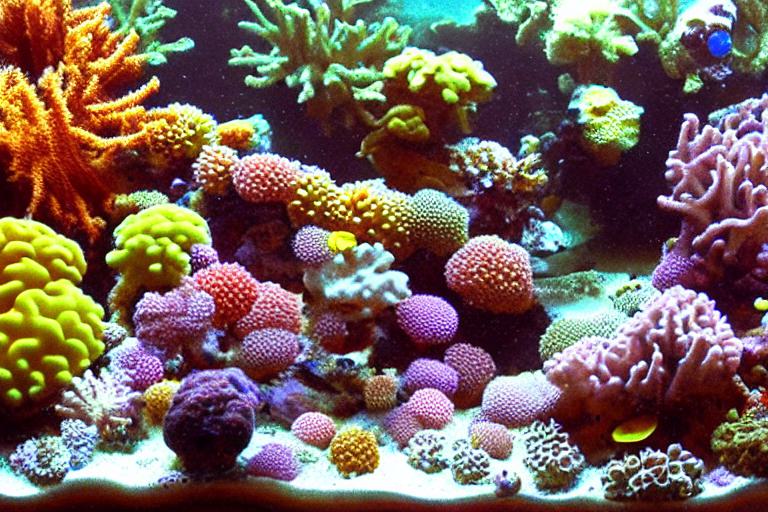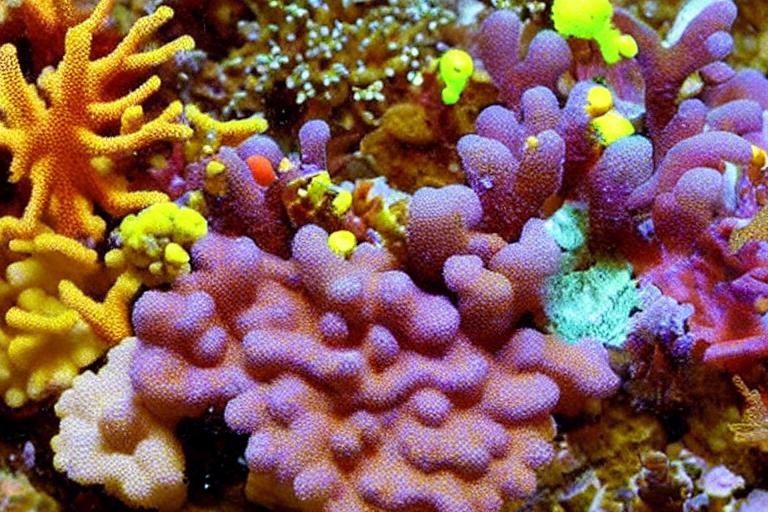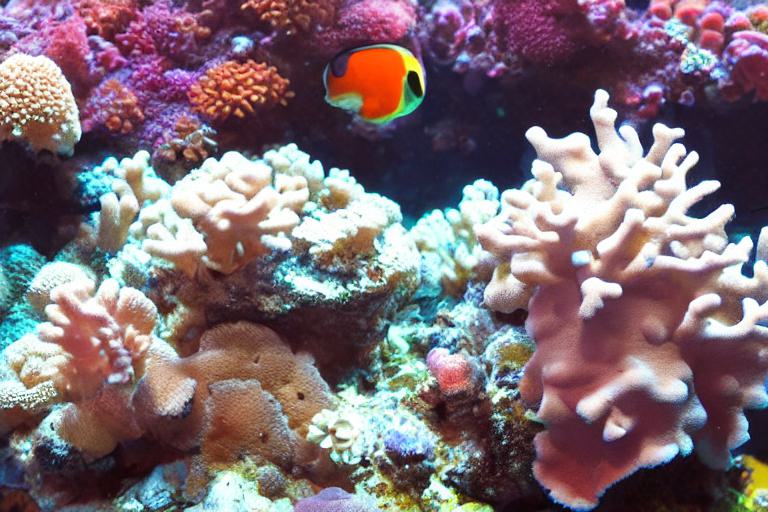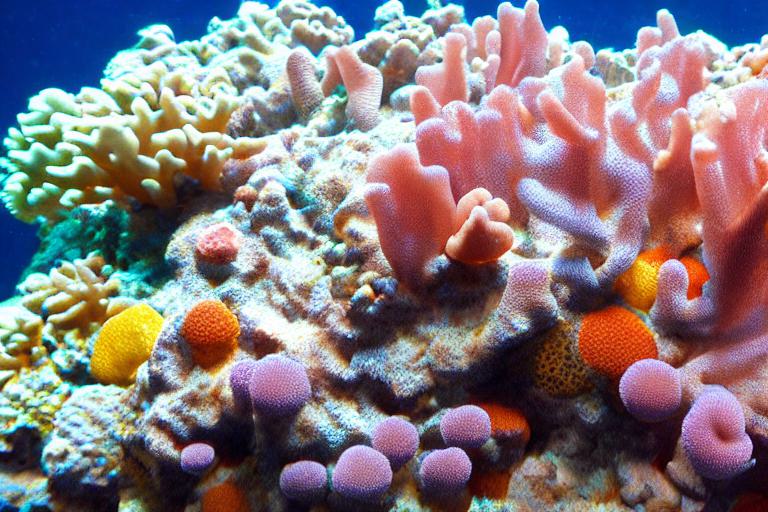If you’re thinking about getting a trumpet coral for your saltwater aquarium, you’re in for a treat. These beautiful corals are relatively easy to care for, and they make a great addition to any reef tank. In this Trumpet Coral Care Guide for Absolute Beginners, we’ll go over everything you need to know to keep your trumpet coral healthy and happy.
Basic Information
If you’re looking to add a trumpet coral to your reef aquarium, there are a few things you need to know first. Here’s a quick care guide to get you started.
They get their name from their shape – they have a long, trumpet-like structure with a wide mouth. Trumpet corals are a type of large polyp stony coral, and are a popular choice for reef aquariums.
Trumpet corals can be found in a variety of colors, including green, brown, and red. They typically grow to be about a foot in diameter, but can get much larger in the wild.
Trumpet corals are relatively easy to care for, but there are a few things to keep in mind. They need moderate lighting and water flow, and should be fed a variety of small meaty foods.
If you’re thinking about adding a trumpet coral to your reef aquarium, keep these care tips in mind and you’ll be sure to have a happy and healthy coral!
Natural Habitat and Appearance
Trumpet coral is found in shallow reef environments and is a popular species for aquariums. Trumpet coral (Caulastrea furcata) is a species of large polyp stony coral in the family Merulinidae. It is a fast-growing coral and can reach a height of up to 2 meters. It is a common coral in the Indo-Pacific region and is also found in the Red Sea. The coral occurs in a wide range of colors, including orange, yellow, green, and brown.
Trumpet coral is a large polyp stony coral with a wide range of colors. Trumpet coral is found in shallow reef environments and is a popular species for aquariums. It is a fast-growing coral that can reach a height of 2 meters.

Placement in a Reef Tank
Proper placement will ensure that your corals receive the right amount of light, water flow, and nutrients. Coral placement in a reef tank is one of the most important aspects of creating a healthy and thriving environment for your corals.
When placing corals in your reef tank, it is important to consider the following factors:
-The type of coral you are placing in the tank
-The size of the coral
-The amount of light the coral needs
-The water flow the coral needs
It is important to remember that corals can be very delicate, so be sure to handle them with care. Once you have considered these factors, you can then begin to place your corals in the tank.
This can be done by placing corals of different sizes, shapes, and colors throughout the tank. Be sure to leave plenty of space between each coral, as they will need room to grow. When placing corals in your reef tank, it is important to create a natural-looking environment.
By following these simple tips, you can create a beautiful and healthy reef tank for your corals.

Water Quality
The pH should be between 8.0 and 8.4. The temperature should be between 72 and 78 degrees Fahrenheit. The water should be clean and free of pollutants. Water quality is one of the most important factors in keeping trumpet coral healthy.
Trumpet coral can be sensitive to changes in water quality, so it is important to test the water regularly and make changes slowly. If the water quality is not ideal, it can cause the coral to bleached or die.
Second, avoid using chemicals in the tank. Third, do regular water changes to keep the water fresh. There are a few things that you can do to help maintain water quality for your trumpet coral. First, use a quality filter to remove impurities from the water.
Calcium
Calcium is one of the most important elements for proper trumpet coral care. Without enough calcium, your coral will not be able to grow and thrive. You can test the calcium levels in your aquarium with a simple test kit available at your local fish store.
To maintain proper calcium levels, you will need to add a calcium supplement to your aquarium water on a regular basis. You can find calcium supplements at your local fish store or online. Be sure to follow the directions on the package carefully.
If you have any questions about trumpet coral care or calcium levels in your aquarium, be sure to ask your local fish store or a qualified aquarium professional for help.
Alkalinity
Coral reefs are also a major source of food and income for millions of people around the world. They are home to 25% of all marine life, including fish, mollusks, and other invertebrates. Coral reefs are some of the most diverse ecosystems on Earth.
It is measured in parts per million (ppm). Alkalinity is a measure of the water’s ability to neutralize acids. The health of coral reefs is directly linked to the alkalinity of the water in which they live.
This is due to a variety of factors, including pollution, overfishing, and climate change. However, many reefs around the world have alkalinity levels that are much lower than this. The ideal alkalinity for coral reefs is between 8 and 12 ppm.
Low alkalinity levels can cause coral bleaching, which is when the coral loses its color and becomes white. Coral bleaching is often fatal to the coral. It is one of the biggest threats to coral reefs around the world.
It will help to increase the alkalinity of the water over time. Live rock is coral that has been harvested from the wild and then placed in an aquarium. First, you can use a product that contains calcium carbonate. Finally, you can do water changes on a regular basis. This will help to increase the alkalinity of the water. There are a number of things that you can do to help increase the alkalinity of the water in your reef aquarium. Second, you can add live rock to your aquarium. This will help to remove any acids that have built up in the water.
By taking these steps, you can help to create a healthy environment for your coral reef.
pH (power of hydrogen)
A pH level that is too high or too low can stress the coral and cause it to become unhealthy. The ideal pH level for trumpet coral is between 8.0 and 8.5. pH, or the power of hydrogen, is an important aspect of trumpet coral care.
If the pH level is too high, you can lower it by adding a small amount of vinegar to the water. If the pH level in your aquarium is too low, you can raise it by adding a small amount of baking soda to the water.
It is important to test the pH level of your aquarium water on a regular basis and make adjustments as needed. By keeping the pH level in the ideal range, you will help your trumpet coral stay healthy and thrive.
Temperature and Flow
Trumpet coral is a type of coral that is found in reefs around the world. Trumpet coral is a beautiful and popular type of coral for aquariums and reef tanks. They are home to a wide variety of plant and animal life, including many species of fish, invertebrates, and reptiles. Coral reefs are some of the most diverse ecosystems on Earth.
The water temperature should be between 74 and 82 degrees Fahrenheit. Trumpet coral also needs to be fed a diet of small meaty foods, such as brine shrimp, mysis shrimp, and plankton. Trumpet coral care is not difficult, but there are a few things to keep in mind. Trumpet coral requires a well-lit aquarium with a moderate water flow.
Trumpet coral is a beautiful and popular type of coral for aquariums and reef tanks. Trumpet coral care is not difficult, but there are a few things to keep in mind. Trumpet coral requires a well-lit aquarium with a moderate water flow. The water temperature should be between 74 and 82 degrees Fahrenheit. Trumpet coral also needs to be fed a diet of small meaty foods, such as brine shrimp, mysis shrimp, and plankton.
Trumpet coral is a beautiful and popular type of coral for aquariums and reef tanks. Trumpet coral care is not difficult, but there are a few things to keep in mind. Trumpet coral requires a well-lit aquarium with a moderate water flow. The water temperature should be between 74 and 82 degrees Fahrenheit. Trumpet coral also needs to be fed a diet of small meaty foods, such as brine shrimp, mysis shrimp, and plankton.
Lighting
Lighting is one of the most important factors in keeping trumpet coral healthy. Trumpet coral need a moderate amount of light, and too much or too little light can cause problems. The best way to provide the right amount of light for trumpet coral is to use a combination of natural sunlight and artificial lighting.
Natural sunlight is the best source of light for trumpet coral, but it can be difficult to provide enough light without causing bleaching. If you live in an area with a lot of sunlight, you can try placing your trumpet coral in a shady spot. If you live in an area with less sunlight, you can try using a grow light to provide the extra light that your coral needs.
Artificial lighting can be provided by a variety of different sources, including fluorescent lights, metal halide lights, and LED lights. Each type of light has its own benefits and drawbacks, so it’s important to do some research to figure out which type of light is best for your coral.
In general, it’s best to provide a mix of both natural sunlight and artificial light to keep your trumpet coral healthy. By providing the right amount of light, you’ll help your coral to thrive and stay healthy for years to come.


Trumpet Coral Threats (Based on the Frequency of Complaints)
This coral is a popular choice for saltwater aquariums because of its beautiful colors and interesting shape. Trumpet coral, also known as Aulostomus chinensis, is a marine invertebrate that is found in warm waters around the world. However, trumpet coral is not without its challenges.
This coral is very sensitive to changes in water quality and temperature, and it is also susceptible to disease. Trumpet coral can also be a nuisance to other aquarium inhabitants, as it has a tendency to spread its tentacles and sting other creatures. One of the most common problems with trumpet coral is that it can be very difficult to care for.
Despite these challenges, trumpet coral can be a beautiful and rewarding addition to a saltwater aquarium. With proper care, this coral can thrive and provide years of enjoyment.
Bleaching & Opening
Coral bleaching and opening are two very important processes in the care of trumpet coral. Bleaching is the process of removing the coral’s symbiotic algae, which provide the coral with food and help to keep it healthy. Opening is the process of removing the coral’s protective mucus layer, which can prevent the coral from getting the nutrients it needs.
The coral is then rinsed with fresh water. The toothbrush is used to scrub the algae off of the coral. Coral bleaching is typically done using a bleach solution and a toothbrush.
The tweezers are used to carefully peel back the coral’s mucus layer. The coral is then rinsed with fresh water. Coral opening is typically done using a pair of tweezers.
Opening helps to ensure that the coral gets the nutrients it needs. Bleaching helps to remove algae that can cause the coral to become unhealthy. Both of these processes are important for the health of the coral.

Infections
They are home to a wide variety of plant and animal life, including many species of fish, invertebrates, and coral. Coral reefs are some of the most diverse ecosystems in the world.
One of the lesser-known threats to coral reefs is disease. Coral reefs are under threat from a variety of environmental stresses, including pollution, climate change, and overfishing.
In some cases, entire reefs can be wiped out by disease. Disease can spread quickly through a coral reef and can have devastating effects. Infections can kill individual coral polyps, leading to the death of the coral.
There is still much to learn about the causes of coral disease and how to prevent it. However, it is clear that healthy coral reefs are vital to the health of the ocean ecosystem and the millions of people who depend on it.
Compatibility with Other Species
Trumpet coral is a peaceful species that does not like to compete for food or space, so it is important to choose tank mates carefully. If you are considering adding trumpet coral to your aquarium, be sure to do your research and ask your local fish store for advice. Some people believe that trumpet coral is incompatible with other species, but this is not necessarily the case. Trumpet coral can actually be quite compatible with other species, provided that the other species is not too aggressive.
Fragging Trumpet Coral
Trumpet coral is a type of large polyp stony coral, and is a popular choice for beginners due to its ease of care. Fragging Trumpet Coral is a great way to get started in the hobby of coral reef keeping. In this article, we’ll give you a step-by-step guide on how to frag your trumpet coral.
Next, you’ll need to find a healthy section of trumpet coral that you’d like to frag. Using a sharp knife or pair of scissors, carefully cut the coral into 1-2 inch pieces. First, you’ll need to purchase a fragging kit, which can be found at your local fish store or online.
Once your pieces are cut, you’ll need to place them into a fragging plug or piece of live rock. Make sure that the frag is securely attached, and then place it into your aquarium.
Trumpet coral can be a little slow to grow, but with proper care, your frag will soon become a beautiful addition to your reef tank.

Feeding Trumpet Coral
Trumpet coral (Caulastrea curvata) is a beautiful and popular coral species that is easy to care for, making it a great choice for beginner reef aquarists. Trumpet coral is a large polyp stony (LPS) coral that can grow to over a foot in diameter. Its large size and fast growth rate make it an excellent candidate for reef aquariums.
Trumpet coral is a voracious feeder and will consume a variety of foods, including frozen and live foods, pellets, and flakes. It is important to feed trumpet coral several times per week to ensure that it receives the nutrients it needs to thrive.
When feeding trumpet coral, it is important to target feed each individual coral. This can be done by using a syringe or small tube to deliver the food directly to the coral. Trumpet coral will also benefit from periodic feedings of coral food supplements, which will help to ensure that it receives all of the nutrients it needs.
Frequently Asked Questions
1. What is a trumpet coral?
A trumpet coral is a type of coral that is shaped like a trumpet. Trumpet corals are found in the oceans around the world.
2. What do trumpet corals eat?
Trumpet corals eat plankton and other small organisms that they filter from the water. Trumpet corals also get nutrients from the algae that live in their tissue.
3. How do trumpet corals reproduce?
Trumpet corals reproduce by releasing eggs and sperm into the water. The eggs and sperm join together to form larvae. The larvae settle on the ocean floor and grow into new trumpet corals.
4. What is the lifespan of a trumpet coral?
The lifespan of a trumpet coral is about 10 years.
5. What are the predators of trumpet corals?
The predators of trumpet corals include fish, crabs, and other animals that eat coral.
6. What is the water temperature range that trumpet corals can tolerate?
Trumpet corals can tolerate a water temperature range of 72-78 degrees Fahrenheit.
7. What is the pH range that trumpet corals can tolerate?
Trumpet corals can tolerate a pH range of 8.2-8.4.
8. What is the salinity range that trumpet corals can tolerate?
Trumpet corals can tolerate a salinity range of 35-40 parts per thousand.
9. What are the lighting requirements for trumpet corals?
Trumpet corals need moderate lighting. They can tolerate some light from the sun, but they do not need direct sunlight.
10. What are the water flow requirements for trumpet corals?
Trumpet corals need moderate water flow.
Final thoughts
If you’re looking to add a trumpet coral to your saltwater aquarium, there are a few things you need to know. First, trumpet coral need plenty of light and water flow to stay healthy. Second, they need to be fed a diet of small meaty foods. Lastly, trumpet coral can be aggressive and should be kept away from other corals. With proper care, your trumpet coral will thrive and add a beautiful addition to your aquarium.
